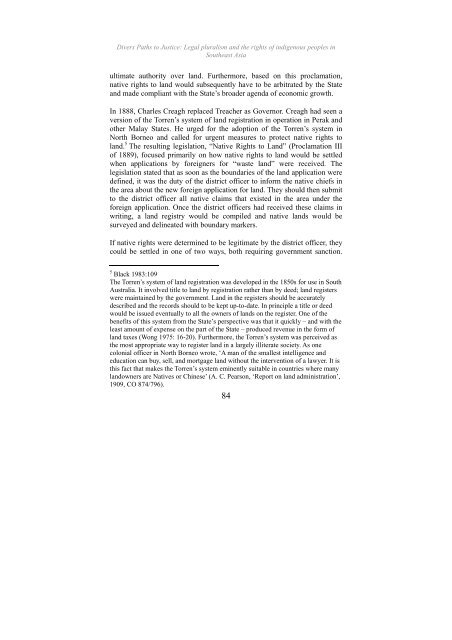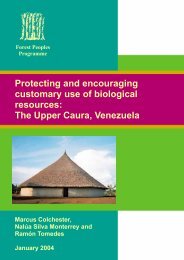Divers Paths to Justice - English - Forest Peoples Programme
Divers Paths to Justice - English - Forest Peoples Programme
Divers Paths to Justice - English - Forest Peoples Programme
Create successful ePaper yourself
Turn your PDF publications into a flip-book with our unique Google optimized e-Paper software.
<strong>Divers</strong> <strong>Paths</strong> <strong>to</strong> <strong>Justice</strong>: Legal pluralism and the rights of indigenous peoples inSoutheast Asiaultimate authority over land. Furthermore, based on this proclamation,native rights <strong>to</strong> land would subsequently have <strong>to</strong> be arbitrated by the Stateand made compliant with the State’s broader agenda of economic growth.In 1888, Charles Creagh replaced Treacher as Governor. Creagh had seen aversion of the Torren’s system of land registration in operation in Perak andother Malay States. He urged for the adoption of the Torren’s system inNorth Borneo and called for urgent measures <strong>to</strong> protect native rights <strong>to</strong>land. 5 The resulting legislation, “Native Rights <strong>to</strong> Land” (Proclamation IIIof 1889), focused primarily on how native rights <strong>to</strong> land would be settledwhen applications by foreigners for “waste land” were received. Thelegislation stated that as soon as the boundaries of the land application weredefined, it was the duty of the district officer <strong>to</strong> inform the native chiefs inthe area about the new foreign application for land. They should then submit<strong>to</strong> the district officer all native claims that existed in the area under theforeign application. Once the district officers had received these claims inwriting, a land registry would be compiled and native lands would besurveyed and delineated with boundary markers.If native rights were determined <strong>to</strong> be legitimate by the district officer, theycould be settled in one of two ways, both requiring government sanction.5 Black 1983:109The Torren’s system of land registration was developed in the 1850s for use in SouthAustralia. It involved title <strong>to</strong> land by registration rather than by deed; land registerswere maintained by the government. Land in the registers should be accuratelydescribed and the records should <strong>to</strong> be kept up-<strong>to</strong>-date. In principle a title or deedwould be issued eventually <strong>to</strong> all the owners of lands on the register. One of thebenefits of this system from the State’s perspective was that it quickly – and with theleast amount of expense on the part of the State – produced revenue in the form ofland taxes (Wong 1975: 16-20). Furthermore, the Torren’s system was perceived asthe most appropriate way <strong>to</strong> register land in a largely illiterate society. As onecolonial officer in North Borneo wrote, ‘A man of the smallest intelligence andeducation can buy, sell, and mortgage land without the intervention of a lawyer. It isthis fact that makes the Torren’s system eminently suitable in countries where manylandowners are Natives or Chinese’ (A. C. Pearson, ‘Report on land administration’,1909, CO 874/796).84
















